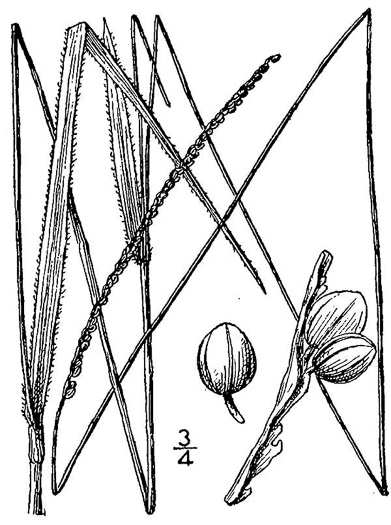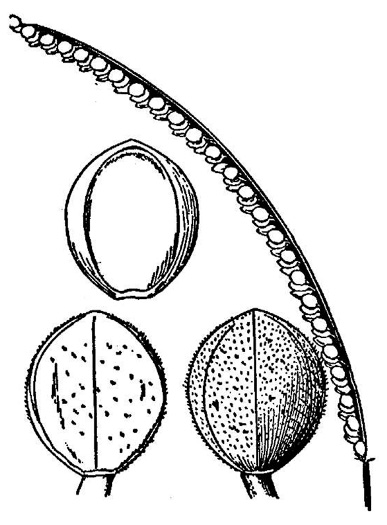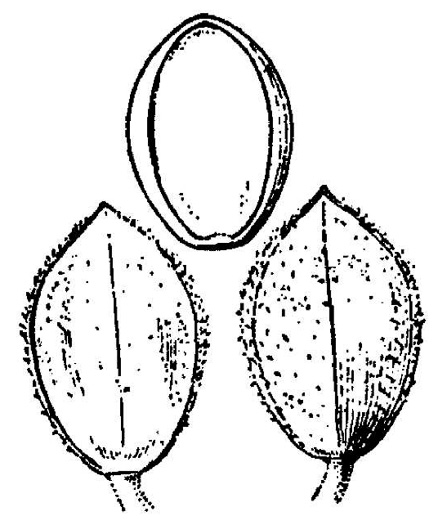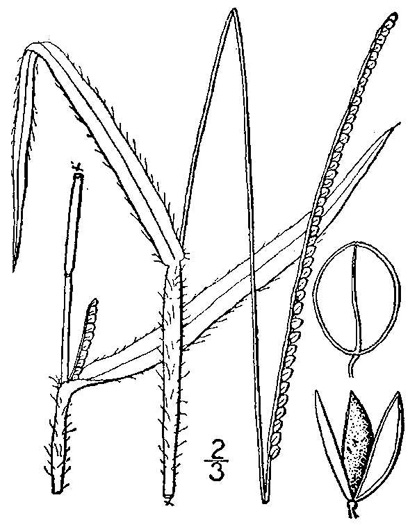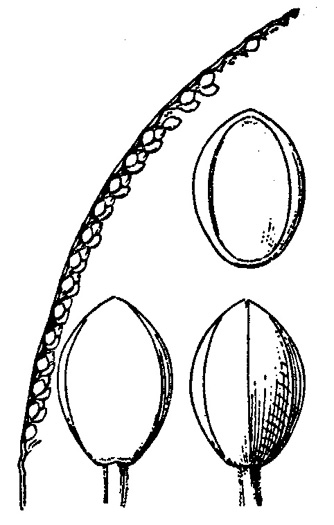Spermatophytes (seed plants): Angiosperms (flowering plants): Monocots: Commelinids: Poales
WEAKLEY'S FLORA OF THE SOUTHEASTERN US (4/24/22):
Paspalum setaceum var. ciliatifolium
FAMILY
Poaceae
Go to FSUS key
Dig deeper at SERNEC, a consortium of southeastern herbaria.
Plants in the P. setaceum group usually grow 1.5-2.5 feet tall, with several well-spaced stem leaves and several +- crowded basal leaves. This variety features +- hairless leaf surfaces, but distinctly pilose margins. Learn more at Vascular Plants of North Carolina.
INCLUDED WITHIN
PLANTS NATIONAL DATABASE:
Paspalum setaceum
FAMILY
Poaceae
INCLUDED WITHIN Floristic Synthesis of North America. BONAP (Kartesz, 2021)
Paspalum setaceum
SYNONYMOUS WITH Flora of North America north of Mexico, vol. 25 (2003)
Paspalum setaceum var. ciliatifolium
SYNONYMOUS WITH Flora of West Virginia (Strausbaugh & Core, 1978)
Paspalum ciliatifolium
INCLUDED WITHIN VASCULAR FLORA OF THE CAROLINAS (Radford, Ahles, & Bell, 1968) 029-74-012:
Paspalum setaceum FAMILY Poaceae
SYNONYMOUS WITH Britton & Brown Illus Flora of Northeast US & adjacent Canada (Gleason, 1952)
Paspalum ciliatifolium var. ciliatifolium
INCLUDING Manual of the Grasses of the US (Hitchcock & Chase, 1950)
Paspalum ciliatifolium
INCLUDING Manual of the Grasses of the US (Hitchcock & Chase, 1950)
Paspalum propinquum
INCLUDING Manual of the Southeastern Flora (Small, 1933, 1938)
Paspalum ciliatifolium
INCLUDING Manual of the Southeastern Flora (Small, 1933, 1938)
Paspalum propinquum
COMMON NAME:
Fringeleaf Paspalum, thin paspalum
To see larger pictures, click or hover over the thumbnails.
WEAKLEY'S FLORA OF THE SOUTHEASTERN US (4/24/22):
Paspalum setaceum var. ciliatifolium
FAMILY
Poaceae
INCLUDED WITHIN
PLANTS NATIONAL DATABASE:
Paspalum setaceum
FAMILY
Poaceae
INCLUDED WITHIN
Floristic Synthesis of North America. BONAP (Kartesz, 2021)
Paspalum setaceum
SYNONYMOUS WITH
Flora of North America north of Mexico, vol. 25
Paspalum setaceum var. ciliatifolium
SYNONYMOUS WITH
Flora of West Virginia (Strausbaugh & Core, 1978)
Paspalum ciliatifolium
INCLUDED WITHIN
VASCULAR FLORA OF THE CAROLINAS (Radford, Ahles, & Bell, 1968) 029-74-012:
Paspalum setaceum
FAMILY
Poaceae
SYNONYMOUS WITH
Britton & Brown Illus Flora of Northeast US & adjacent Canada (Gleason, 1952)
Paspalum ciliatifolium var. ciliatifolium
INCLUDING
Manual of the Grasses of the US (Hitchcock & Chase, 1950)
Paspalum ciliatifolium
INCLUDING
Manual of the Grasses of the US (Hitchcock & Chase, 1950)
Paspalum propinquum
INCLUDING
Manual of the Southeastern Flora (Small, 1933, 1938)
Paspalum ciliatifolium
INCLUDING
Manual of the Southeastern Flora (Small, 1933, 1938)
Paspalum propinquum
If a search such as "Carex leptalea var. leptalea" doesn't deliver the results you want, try "Carex leptalea".
Or, to minimize chances of a misspelling, try just "Carex le".
Less is more: If "pencil flower" doesn't deliver the results you want, try "pencil".

